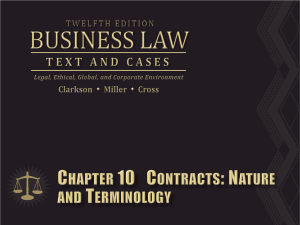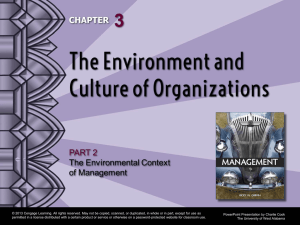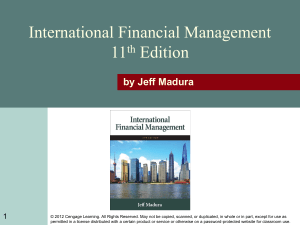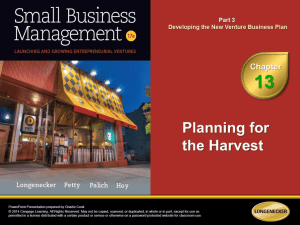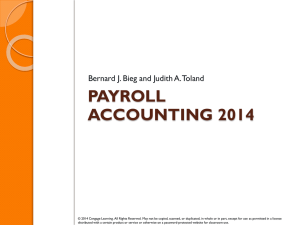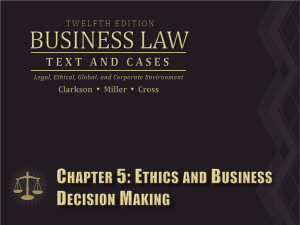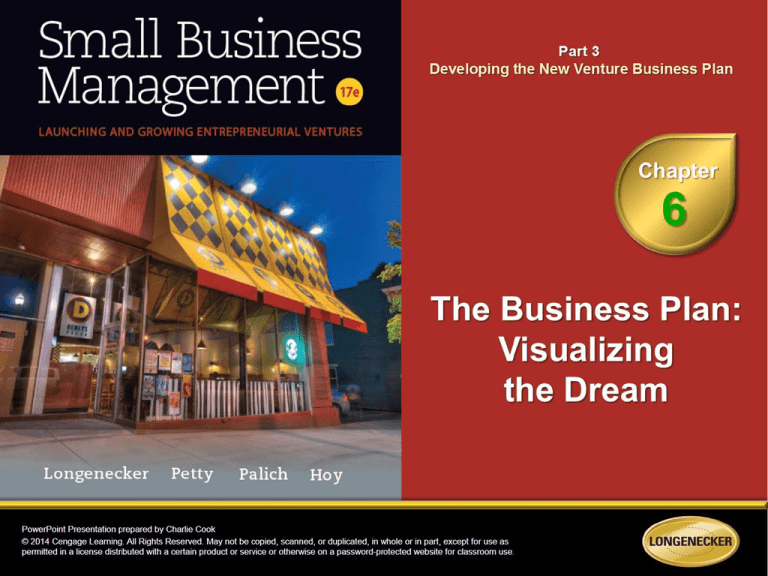
1. Explain the purpose and objectives of business
plans.
2. Give the rationale for writing (or not writing)
a business plan when starting a new venture.
3. Describe the preferred content and format for
a business plan.
4. Offer practical advice on writing a business plan.
5. Explain the concept and process for developing
a firm’s business model.
© 2014 Cengage Learning. All Rights Reserved. May not be copied, scanned, or duplicated, in whole or in part, except for use as
permitted in a license distributed with a certain product or service or otherwise on a password-protected website for classroom use.
6–2
6. Identify available sources of assistance
in preparing a business plan.
7. Maintain the proper perspective when writing
a business plan.
© 2014 Cengage Learning. All Rights Reserved. May not be copied, scanned, or duplicated, in whole or in part, except for use as
permitted in a license distributed with a certain product or service or otherwise on a password-protected website for classroom use.
6–3
An Overview of the Business Plan
• Business Plan
Outlines the basic concept underlying a business—
what problem will be solved—and describes how the
business will execute its plan to solve the problem
• Key Elements of a Business Plan
A logical statement of a problem and its solution
A significant amount of cold, hard evidence
Candor about the risks, gaps, and assumptions that
might be proved wrong.
© 2014 Cengage Learning. All Rights Reserved. May not be copied, scanned, or duplicated, in whole or in part, except for use as
permitted in a license distributed with a certain product or service or otherwise on a password-protected website for classroom use.
6–4
6.1
Users of Business Plans
© 2014 Cengage Learning. All Rights Reserved. May not be copied, scanned, or duplicated, in whole or in part, except for use as
permitted in a license distributed with a certain product or service or otherwise on a password-protected website for classroom use.
6–5
Will Writing a Plan Make a Difference?
• Primary Functions
To provide a clearly articulated statement of goals
and strategies for internal use
Imposes discipline on the entrepreneur and management
team
To serve as a selling document to be shared with
outsiders
Provides a credible overview for prospective customers,
suppliers, and investors
Helps secure favorable credit terms from suppliers
Opens approaches to lenders and other sources of financing
© 2014 Cengage Learning. All Rights Reserved. May not be copied, scanned, or duplicated, in whole or in part, except for use as
permitted in a license distributed with a certain product or service or otherwise on a password-protected website for classroom use.
6–6
The Balance Between Planning
and Executing
• Factors affecting the extent of a business plan:
Cost in time and money to prepare the plan
Management style and ability
Preferences of the management team
Complexity of the business
Competitive environment
Level of uncertainty
© 2014 Cengage Learning. All Rights Reserved. May not be copied, scanned, or duplicated, in whole or in part, except for use as
permitted in a license distributed with a certain product or service or otherwise on a password-protected website for classroom use.
6–7
Types of Business Plans
• The Short Plan
A abbreviated form of a traditional business plan
that presents only the most important issues and
projections.
• The Comprehensive Plan
A complete that provides an in-depth
analysis of the critical factors that
will determine a firm’s success
or failure, along with all
the underlying assumptions.
© 2014 Cengage Learning. All Rights Reserved. May not be copied, scanned, or duplicated, in whole or in part, except for use as
permitted in a license distributed with a certain product or service or otherwise on a password-protected website for classroom use.
6–8
Preparing a Business Plan
• Issues critical in preparing a business plan:
The content and basic format of the plan
Factual support for the concept in the form of strong
supporting evidence
The effectiveness of the written presentation
Clear writing that effectively communicates
© 2014 Cengage Learning. All Rights Reserved. May not be copied, scanned, or duplicated, in whole or in part, except for use as
permitted in a license distributed with a certain product or service or otherwise on a password-protected website for classroom use.
6–9
Content of a Business Plan
• Factors that help determine the content of a
business plan for a startup:
The opportunity
Critical resources
The entrepreneurial team
The financing structure
The context
(or external factors)
© 2014 Cengage Learning. All Rights Reserved. May not be copied, scanned, or duplicated, in whole or in part, except for use as
permitted in a license distributed with a certain product or service or otherwise on a password-protected website for classroom use.
6–10
6.2
A Business Plan Identifies the Key Factors for Success
© 2014 Cengage Learning. All Rights Reserved. May not be copied, scanned, or duplicated, in whole or in part, except for use as
permitted in a license distributed with a certain product or service or otherwise on a password-protected website for classroom use.
6–11
Major Sections of Business Plans
Section Headings
• Cover Page
• Table of Contents
• Executive Summary
•
•
•
•
Industry, Target Customer, and Competitor Analysis
Company Description
Product/Service Plan
Marketing Plan
•
•
•
•
•
Operations and Development Plan
Management Team
Critical Risks
Offering
Exit Strategy
• Financial Plan
• Appendix of Supporting Documents
© 2014 Cengage Learning. All Rights Reserved. May not be copied, scanned, or duplicated, in whole or in part, except for use as
permitted in a license distributed with a certain product or service or otherwise on a password-protected website for classroom use.
6–12
6.3
Abbreviated Business Plan Outline
© 2014 Cengage Learning. All Rights Reserved. May not be copied, scanned, or duplicated, in whole or in part, except for use as
permitted in a license distributed with a certain product or service or otherwise on a password-protected website for classroom use.
6–13
The Content of a Business Plan
• Cover Page
Company name, address, phone number, fax
number, and website
Tagline and company logo
Name and contact information of contact person
Date on which the business plan was prepared
Confidentiality disclaimer
Number of the copy
• Table of Contents
Provides a sequential listing of the sections of the
plan, with page numbers
© 2014 Cengage Learning. All Rights Reserved. May not be copied, scanned, or duplicated, in whole or in part, except for use as
permitted in a license distributed with a certain product or service or otherwise on a password-protected website for classroom use.
6–14
6.4
Table of Contents for BlueAvocado Business Plan
© 2014 Cengage Learning. All Rights Reserved. May not be copied, scanned, or duplicated, in whole or in part, except for use as
permitted in a license distributed with a certain product or service or otherwise on a password-protected website for classroom use.
6–15
The Content of a Business Plan (cont’d)
• Executive Summary
(Overview/Synopsis/Narrative)
Description of the opportunity
Explanation of the business concept
Industry overview
Target market
Competitive advantage to be achieved in the market
Economics of the opportunity
Management team description
Amount and purpose of the money being requested
(the “offering”) if seeking financing
© 2014 Cengage Learning. All Rights Reserved. May not be copied, scanned, or duplicated, in whole or in part, except for use as
permitted in a license distributed with a certain product or service or otherwise on a password-protected website for classroom use.
6–16
6.5
BlueAvocodo Overview
© 2014 Cengage Learning. All Rights Reserved. May not be copied, scanned, or duplicated, in whole or in part, except for use as
permitted in a license distributed with a certain product or service or otherwise on a password-protected website for classroom use.
6–17
The Content of a Business Plan (cont’d)
• Industry Description
Broader industry in which the firm will compete
Industry size, growth rate, trends, and competitors
Different segments of the industry
Niche in which the firm plans to participate
• Target Customers
Demographics and psychological variables—values,
attitudes, and fears
• Competitor Analysis
Product or service attributes that are or are not
provided by competitors
© 2014 Cengage Learning. All Rights Reserved. May not be copied, scanned, or duplicated, in whole or in part, except for use as
permitted in a license distributed with a certain product or service or otherwise on a password-protected website for classroom use.
6–18
The Content of a Business Plan (cont’d)
• Company Description
When and where was this business started?
What is the history of the company?
What are the firm’s objectives?
What changes in structure and/or ownership?
In what stage of development is the firm?
What has been achieved to date?
What is the firm’s distinctive competence?
What are the nature and activity of the business?
What is its primary product or service?
What customers will be served?
What is the firm’s form of organization?
What are the projected economic states of the industry?
How is ownership of the firm to be structured?
© 2014 Cengage Learning. All Rights Reserved. May not be copied, scanned, or duplicated, in whole or in part, except for use as
permitted in a license distributed with a certain product or service or otherwise on a password-protected website for classroom use.
6–19
The Content of a Business Plan (cont’d)
• Product/Service Plan
Describes the product and/or service to be provided
and explains its merits
• Marketing Plan
Describes the user benefits of the product or service
and the type of market that exists
• Operations and Development Plan
How product will be produced or service provided
• Management Team
Describes the firm’s organizational structure and the
backgrounds and qualifications of key personnel
© 2014 Cengage Learning. All Rights Reserved. May not be copied, scanned, or duplicated, in whole or in part, except for use as
permitted in a license distributed with a certain product or service or otherwise on a password-protected website for classroom use.
6–20
The Content of a Business Plan (cont’d)
• Critical Risks
Identifies the potential risks that may be encountered
by an investor
• Offering
Indicates to an investor how much money is needed
and when, and how the money will be used
• Exit Strategy
Lists the possible options for equity investors to
recover their principal investment and any returns
through cashing out of their investment.
© 2014 Cengage Learning. All Rights Reserved. May not be copied, scanned, or duplicated, in whole or in part, except for use as
permitted in a license distributed with a certain product or service or otherwise on a password-protected website for classroom use.
6–21
The Content of a Business Plan (cont’d)
• Financial Plan
Projects the company’s financial position based on
well-substantiated assumptions and explains of how
the figures have been determined
Pro forma statements
Projections of a company’s financial statements for up to five
years, including balance sheets, income statements, and
statements of cash flows, as well as cash budgets.
© 2014 Cengage Learning. All Rights Reserved. May not be copied, scanned, or duplicated, in whole or in part, except for use as
permitted in a license distributed with a certain product or service or otherwise on a password-protected website for classroom use.
6–22
The Content of a Business Plan (cont’d)
• Appendix of Supporting Documents
Supplementary materials and attachments to expand
the reader’s understanding of the plan:
Résumés of key investors and owners/managers
Professional references
Photographs of products, facilities, and buildings
Marketing research studies
Pertinent published research
Signed contracts of sale
© 2014 Cengage Learning. All Rights Reserved. May not be copied, scanned, or duplicated, in whole or in part, except for use as
permitted in a license distributed with a certain product or service or otherwise on a password-protected website for classroom use.
6–23
Advice for Writing a Business Plan
Analyze the market
thoroughly
Pay attention
to details
Provide solid
evidence for claims
Maintain
confidentiality
Think like
an investor
Don’t hide weaknesses—
identify potential fatal flaws
© 2014 Cengage Learning. All Rights Reserved. May not be copied, scanned, or duplicated, in whole or in part, except for use as
permitted in a license distributed with a certain product or service or otherwise on a password-protected website for classroom use.
1–24
Advice for Writing a Business Plan
• Analyze the Market Thoroughly
What is the target market?
How large is the target market?
What problems concern the target market?
Are any of these problems greater than the one you’re
addressing?
How does your product or service fix the problem?
Who will buy your product or service?
How much are they willing to pay for it?
Why do they need it?
Why would they buy from you?
Who are your competitors?
What are their strengths and weaknesses?
© 2014 Cengage Learning. All Rights Reserved. May not be copied, scanned, or duplicated, in whole or in part, except for use as
permitted in a license distributed with a certain product or service or otherwise on a password-protected website for classroom use.
6–25
What Not to Do
• Mistakes to avoid in preparing a business plan:
Failing to provide solid data.
Failing to describe the product in lay terms.
Failing to thoroughly analyze the market.
Including financial statements that are overly detailed
or incomplete.
Hiding weaknesses.
Overlooking the fatal flaw.
Using bad grammar.
Making the overall plan too long.
© 2014 Cengage Learning. All Rights Reserved. May not be copied, scanned, or duplicated, in whole or in part, except for use as
permitted in a license distributed with a certain product or service or otherwise on a password-protected website for classroom use.
6–26
Presenting Business Plan to Investors
• Understanding the Investor’s Perspective
Entrepreneurs are optimists; investors are skeptics.
Investors seek to maximize return through cash flow
while minimizing exposure to risk.
Bad information and poor preparation cause investors
to lose interest quickly.
• The Investor’s Short Attention Span
A business plan must be an effective marketing
document that quickly captures investor interest.
© 2014 Cengage Learning. All Rights Reserved. May not be copied, scanned, or duplicated, in whole or in part, except for use as
permitted in a license distributed with a certain product or service or otherwise on a password-protected website for classroom use.
6–27
Plan Features that Attract Investors
• Plans that speak the investors’ language:
Are market-oriented in meeting identifiable customer
needs; are not product-oriented.
Show evidence of target customer acceptance of the
proposed product or service.
Present credible and not overly optimistic financial
projections.
Are not a formal prospectus or
offering memorandum.
© 2014 Cengage Learning. All Rights Reserved. May not be copied, scanned, or duplicated, in whole or in part, except for use as
permitted in a license distributed with a certain product or service or otherwise on a password-protected website for classroom use.
6–28
Making an Effective Written Presentation
•
•
•
•
•
•
•
•
Use good grammar
Limit the presentation to a reasonable length
Go for an attractive, professional appearance
Provide solid evidence for any claims
Describe the product in lay terms
Emphasize the qualifications of the management team
Analyze the market thoroughly
Include financial statements that are neither overly
detailed nor incomplete
• Don’t hide weaknesses—identify potential fatal flaws
• Maintain and insist on confidentiality
© 2014 Cengage Learning. All Rights Reserved. May not be copied, scanned, or duplicated, in whole or in part, except for use as
permitted in a license distributed with a certain product or service or otherwise on a password-protected website for classroom use.
6–29
Suggestions for Writing a Business Plan
• Provide table of contents and section tabs.
• Use a loose-leaf binder in case of revisions.
• Use visual aids—graphs, exhibits, and tabular
summaries.
• Indicate that all information is confidential.
• Number copies of the plan and require written
receipts.
• Be careful about divulging competitive
information or proprietary designs/technology.
• Ask other entrepreneurs to review the plan.
© 2014 Cengage Learning. All Rights Reserved. May not be copied, scanned, or duplicated, in whole or in part, except for use as
permitted in a license distributed with a certain product or service or otherwise on a password-protected website for classroom use.
6–30
Understanding the Business Model
• Business Model
Analysis of how a firm plans to create profits and cash
flows given its revenue sources, its cost structures,
required size of investment, and sources of risk.
• Business Model Elements
1. The revenue model defines the nature and types of a firm’s
sources of revenues
2. The cost structures that drive the company’s costs and
expenses
3. The maximum investment that will be required to make the
business profitable and cash flows positive
4. Business model risk identifies risks in the model and how the
model can adjust to them
© 2014 Cengage Learning. All Rights Reserved. May not be copied, scanned, or duplicated, in whole or in part, except for use as
permitted in a license distributed with a certain product or service or otherwise on a password-protected website for classroom use.
6–31
The Business Model: Revenues
• Revenue Streams
• Revenue Model Types
Single stream
Volume or unit-based
Multiple streams
revenue model
Subscription/membership
revenue model
Advertising-based
revenue model
Licensing revenue model
Interdependent
streams
Loss leader
© 2014 Cengage Learning. All Rights Reserved. May not be copied, scanned, or duplicated, in whole or in part, except for use as
permitted in a license distributed with a certain product or service or otherwise on a password-protected website for classroom use.
6–32
6.6
Basic Business Model Framework
© 2014 Cengage Learning. All Rights Reserved. May not be copied, scanned, or duplicated, in whole or in part, except for use as
permitted in a license distributed with a certain product or service or otherwise on a password-protected website for classroom use.
6–33
Forecasting Future Revenues
1. Who are your most likely customers?
2. How are they different from the general population?
3. What events will trigger the need or desire for your type of product
or service?
4. When will this trigger occur? Can it be predicted?
5. How will customers make decisions on whether or not to buy your
product or service?
6. What will be the key decision factors?
7. How will your product or service compare to that of the
competition on these key factors?
8. Will these differences be meaningful to the customer?
9. Are these differences known to the customer?
10. How can the product or service be exposed to potential
customers?
© 2014 Cengage Learning. All Rights Reserved. May not be copied, scanned, or duplicated, in whole or in part, except for use as
permitted in a license distributed with a certain product or service or otherwise on a password-protected website for classroom use.
6–34
Cost Structures
• Fixed Costs
Costs that do not vary at all with volume, such as rent
expenses.
• Variable Costs
Expenses that vary directly and proportionately with
changes in the activities of the firms.
• Semi-variable Costs
Expenses that include both variable costs and fixed
costs which vary, but not proportionately, with
increased or decreased activities of the firm.
© 2014 Cengage Learning. All Rights Reserved. May not be copied, scanned, or duplicated, in whole or in part, except for use as
permitted in a license distributed with a certain product or service or otherwise on a password-protected website for classroom use.
6–35
Maximum Investment
• Maximum Investment
Provides estimates of the types and amounts of
investment required to achieve positive profits and
cash flows.
Hard assets (equipment and buildings)
Amount of working capital in the form of operating cash
Accounts receivable
Inventory
© 2014 Cengage Learning. All Rights Reserved. May not be copied, scanned, or duplicated, in whole or in part, except for use as
permitted in a license distributed with a certain product or service or otherwise on a password-protected website for classroom use.
1–36
Managing Business Model Risk
• Business Model Risk
A component of the business model that identifies
risks in the model (e.g., changing economic
circumstances) and how the model can adjust to
them.
© 2014 Cengage Learning. All Rights Reserved. May not be copied, scanned, or duplicated, in whole or in part, except for use as
permitted in a license distributed with a certain product or service or otherwise on a password-protected website for classroom use.
1–37
Resources for Business Plan Preparation
• Computer-Aided Business
Planning
Word-processors
• Professional Assistance
(cont’d)
Small business
Spreadsheets
Specialized business plan
software packages
• Professional Assistance
Accountants
Marketing specialists
Attorneys
Investment banker
Financial intermediary
development centers
(SBDCs)
Incubator organizations
Regional and local
economic development
offices.
Service Corps of Retired
Executives (SCORE)
FastTrac Entrepreneurial
Training Program
© 2014 Cengage Learning. All Rights Reserved. May not be copied, scanned, or duplicated, in whole or in part, except for use as
permitted in a license distributed with a certain product or service or otherwise on a password-protected website for classroom use.
6–38
Keeping The Right Perspective
• Good business plans don’t ensure success.
Effective implementation is what succeeds.
• Writing a business plan is an ongoing process
and only secondarily the means to an outcome.
The process is just as important as—if not more so
than—the finished product.
The plan represents what is has been anticipated; a
good entrepreneur adapts the plan to fit the
unexpected.
© 2014 Cengage Learning. All Rights Reserved. May not be copied, scanned, or duplicated, in whole or in part, except for use as
permitted in a license distributed with a certain product or service or otherwise on a password-protected website for classroom use.
6–39
Key Terms
business model
business model risk
business plan
comprehensive plan
cost structures
critical risks
executive summary
exit strategy
financial plan
management team
marketing plan
maximum investment
offering
operations and
development plan
product/service plan
pro forma statements
revenue model
short plan
© 2014 Cengage Learning. All Rights Reserved. May not be copied, scanned, or duplicated, in whole or in part, except for use as
permitted in a license distributed with a certain product or service or otherwise on a password-protected website for classroom use.
6–40



